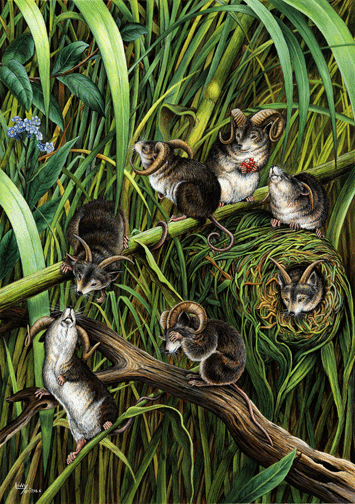- Part I, absurd.
- Part II, utterly senseless.
- Part III, slapstick silly.
- Part IV, satire.
Satire is a rather dangerous sort of comedy. Frankly, it’s intent is to shame individuals, or society itself, into improving by using constructive social criticism through wit. The weapon of wit is truly a subjective thing and sometimes it carries a wallop quite similar to the bite of dog; rather than the more noble nibble of a sheep. In that case satire more closely resembles sarcasm and that kind of humour is generally down right mean.
I do believe Americans love satire ... at least those of my generation. I never thought much about it growing up but, now that I’m older and a bit more reflective, I understand the difference between Rowan & Martin’s Laugh-In and the original Saturday Night Live. For sure, good satire will offer lighthearted humour full of irony or parody, and follow that up with a serious after-taste. In simpler terms; make people laugh, and then encourage them think.
When I began creating the Wilderlife Series I intended to use satire to make fun of both the pompous art world as well as the smarter than me biologist types. That in itself was very easy to do, yet once my family and I began really exploring the imagination we sometimes went a bit farther than I ever planned. A great example is the two shrew-type critters. I believe it was Goldie who began the idea that we should create opposing cultures similar to the relationship shared between England and France. (Put this in historic context, if you will ... over the centuries those nations across the pond have been contentious neighbours who often sound like the Bickersons. What fun to play with that idea!)
Take a read and see if you get what I mean:
COMMON NAME: Great Horned Shrew
Species: Tres hornicus rodenteon. Other names include little big horn, half pint, wee body, shrewy wooy, and knuckle buster. The great horned shrew can be confused with it’s close relative, the grey horned shrew.
General facts: Great horned shrews are hyperactive omnivores that grow 1 and a half to 2 inches long from butt to nose and weigh between 5 and 7 ounces. They feed primarily on grass seeds, but also eat other things such as ear mites, noseeums, fly larvae, and rabbit. They are surprisingly successful pack hunters that can cleverly take down a 10 pound mammal. With an excellent sense of smell and hearing, the scout-rodent identifies potential prey and communicates direction to his fellow pack members using teeny squeaks and whisker wiggles. The pack will then position itself around the target and charge with a mighty lunge. In the midst of the frenzied activity, few who fall pray to a shrew-trap can escape. Using razor sharp teeth and jaw pressure of 87 pounds, a large rabbit will be dismembered in less than 20 minutes. Contrary to popular belief, their horns are not used when hunting. Like dahl sheep, their head adorns are used when fighting for mates, communication, and back scratching.
STATISTICS: Great horned shrew live in colonies that range from 2,200 to 5,702 animals. They have a feudal social structure that is comparable to 12th century France. Basically, it is many mini-kingdoms controlled by one. The highest level of their society does not have to hunt at all. Serf hunters of the pack give most of their catch to the vassals, who give some of that catch to the lords, who in turn contributes a little bit more to the hierarchy’s cache. Generally speaking, great horned shrew have a snooty disposition, again relating to 12th century France. They have an unusual sense of family structure, appearing to be big on courtship and giving little regard to monogamy. It is difficult to tell the genders apart and statistical information on the animal count is nothing more than mere speculation. Their greatest enemy is the grey horned shrew that resides just across the river.
HABITAT: North America and parts of Canada. Resides just about anywhere it can get away with. Most sightings have occurred in Quebec and the interior of Alaska. It is rumored that they were once abundant in Louisiana, most specifically in and around New Orleans.
** Morning Glory
Gouache on Bristol Board
_____________________________________________
COMMON NAME: Grey Horned Shrew
Species: Nutralous hornicus rodenteon. Other names include english shrew, quarter pint, ye body, winston, and knobby nibbler. The grey horned shrew can be confused with it’s close relative, the great horned shrew.
General facts: Grey horned shrews are lethargic omnivores that grow 2 to 1 and a half inches long from butt to nose and weigh between 7 and 5 ounces. They feed primarily on berries, oysters, and other aphrodisiacs, but also eat other things such as fleas, wild lettuce, green m&ms, and rabbit. They are surprisingly successful scavengers that can cleverly take food from their enemies. With an excellent sense of smell and hearing, they can detect the enemy approaching and run like the wind. The pack hunts only at night, taking full advantage of slumbering neighbours’ unguarded caches. During day hours this shrew never strays far from it’s home and behaves like simple gatherers searching for berries and other pleasurable things. Grey horned shrew are never seen alone and are easily identified by their never ending attentiveness to their mate. They are very affectionate creatures, constantly petting, doting, and caring for other members of their clan.
STATISTICS: Grey horned shrew live in colonies that range from 5,702 to 2,204 animals. They have a monarchy social structure that is comparable to 12th century England. Basically, it is huge kingdom controlled by one. The highest level of their society does not have to hunt at all, for it is adored by every member of the group who will gladly give all they own to the apparent lordship of them all. Generally speaking, grey horned shrew have a refined disposition, again relating to 12th century England. They have a traditional sense of family structure, appearing to be big on monogamy and giving little regard to courtship. All their nests are built near by the wildflower known as Forget Me Not. It is speculated that the scent of the blooms perform a major function during the mating season. Perhaps it is an aphrodisiac, or maybe it just looks pretty. The grey horned shrew’s major enemy is the great horned shrew, that resides just across the river.
HABITAT: North America and parts of New England. Resides, or has resided, in just about every region of the world. Most sightings have occurred in Victoria, on Vancouver Island, British Columbia, and in smattered locations throughout South Central Alaska. It is rumored that they were once abundant in Massachusetts, most specifically in and around Boston. Evidently, there still seems to be a thriving colony on the Faulken Islands.
** Procreation Congregation
Gouache on Bristol Board
_____________________________________________













